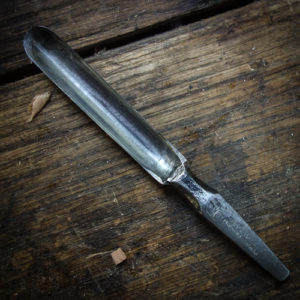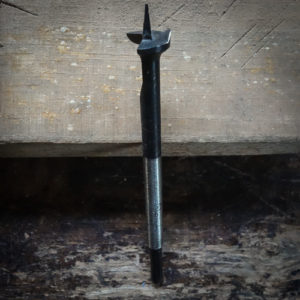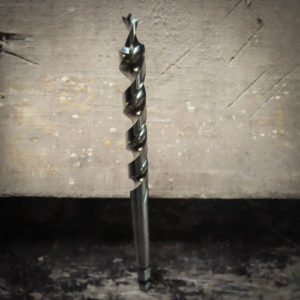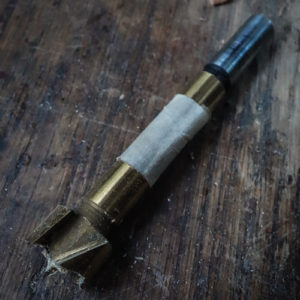The following are my thoughts on drill bits for Windsor chairmaking. Bear in mind that I have used some of these bits (augers, bradpoints, etc.) daily for 15 years and other bits I have used infrequently. In these reviews, I am comparing well tuned examples of each bit. Poorly tuned bits will make an awful mess regardless of type.

Spoon Bit
Spoon bits: The traditional bit of the Windsor chairmaker. Advantages – cuts clean holes even at extreme angles, thickness of shaving changes relative to hardness of wood being cut, is fun to use, operator can easily change angles at anytime. Disadvantages: Hard to sharpen. The diameter of the bit changes with many sharpenings. The shortness of the bit makes it harder to sight accurately (this can be overcome with an extension). It requires skill to start the hole in the right place or a gouge to hollow a spot for starting the bit. New bits either don’t work or require considerable tune up. Lee Valley’s spoon bits don’t work in dry hardwoods. Old bits can be hard to find.

Powerbore
Stanley Powerbore: When boring stretcher mortises with handtools, I have used the Powerbore in a breast drill to start a hole, then finish with an auger – the Powerbore allows clean holes at a steep angle and the auger bit removes wood more efficiently. Lee Valley makes a similar bit, designed for green woods or softwoods . Most of my holes are in dry hardwoods, which it doesn’t work well for at all. Advantages: Has long point enabling steep hole angles. Does not tear entry hole even at slow RPMs. Disadvantages: Only made for a short period of time, though they can sometimes be found in original packaging on Ebay.

Auger Bit
Auger bits: My choice for all holes that aren’t too steep an angle. Has to be used in a hand brace, though it can be chucked into a electric drill if the tangs are cut off (don’t try this with bits much bigger than 1/2″ or the torque will be too great). Advantages: Clean entry holes (and exit holes if you back-bore). Readily and cheaply available used. Easy to sharpen. Disadvantages: Tearout at extreme angles.

Cook’s Patent Bit
Cook’s Patent Bit: A clone between a spoon bit and an auger bit, these bits were invented by Ransom Cook in the mid-nineteenth century. Advantages: You can bore all the way through the board without any exit hole tear out. Disadvantages: They are hard to find and quite hard to sharpen.

Homemade Bradpoint
Bradpoints: My choice for stretcher mortices. Advantages: Clean cuts at any angle (assuming the point is long enough). Can be made from cheap twist drills to a variety of shapes and uses. Disadvantages: Must be used in an electric drill. Doesn’t cut as elegantly as a auger bit, especially in softwoods.

Kreg jig bit
Kreg jig bit: My choice for angled spindle holes in backs (Continuous Arm, Sack Back, Loop back, etc.). I mostly use the ‘Micro’ size which is 3/10″ diameter. Advantages: works in a bit brace or an electric drill, though the cordless drill leaves slightly cleaner holes. Fairly clean entry and exit holes. Long enough to easily sight with. Disadvantages: Needs an awl hole to start, or the tip needs to be ground to a bradpoint.

Forstner Bit
Forstner: This bit only works well with holes close to 90 degrees, for it has a very short point. Therefore it’s use is extremely limited for American Windsor chairs.
Wood Owl: These modified auger bits don’t have many advantages for chairmaking.

P.S.
Add Owl auger bits to the list. They cut fast and clean.
Your thoughts?
Regards from Perth
Derek
I haven’t tried the owl bits, but I’d like to one day. Elia
Hi Elia
About the lead screw …
I recall reading a tip in Pop Wood mag a few years ago about drilling a pilot hole for the short point of a forstner bit. This works as the forstner does not have to create the hole to follow. A while back I thought to use this idea when drilling with auger bits in hard wood. Hard wood, especially Australian hard woods, make it difficult for the auger lead screw to gain traction and pull itself into the wood. So I began pre-drilling a pilot with a thin twist drill (1/8″ will do it), and following with the auger and brace. Drilling hard woods has never been easier! Try it.
Regards from Perth
Derek
Curious about the auger bots. Do you use the single flute for softer woods and double fite (Jennings) for harder woods?
Bits and flute. Stupid phone and big fingers.
The lead screw controls the thickness of cut. Jennings (double flute) style bits often have a double-thread lead screw so they look like they’d cut really slowly, but they actually cut roughly the same speed as many Irwin (single flute) style bits which often have a single thread lead screw. Individual bits of either type can vary drastically in terms of of speed. I have one 1/2″ bit that cuts 1″ deep in 12 revolutions and another 1/2″ bit that takes over 20 revolutions.